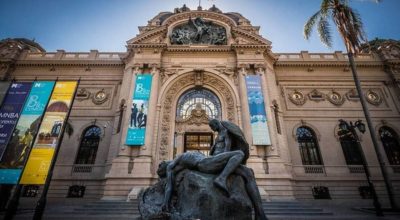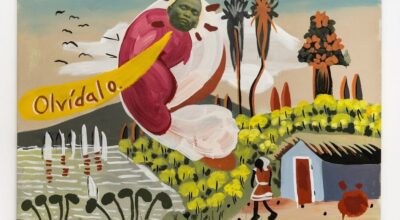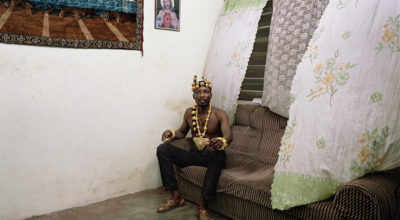English
MAKE ART A FORM OF UNIVERSAL LITERACY. A LETTER FROM LUIS CAMNITZER
For Luis Camnitzer, the current global health crisis reveals how fragile the definition of museum has always been, how it helped create an art bubble by now held together by a flimsy web of financial threads. And worse, how the exhibition industry doesn’t help but is actually an obstacle to good education. New York’s MoMA letter firing its freelance educators illustrates a prevailing belief: if no people come to a show, there is no consumption and therefore, no education
LOIE HOLLOWELL: GOING SOFT
Loie Hollowell’s pastel drawings for «Going Soft» explore the physical and psychological experiences of pregnancy, birth, and postpartum. Serving as abstracted self-portraits, each drawing reveals the artist’s interior psyche at the time of the work’s creation. Her online exhibition is at Pace Gallery (New York).
BEAUTIFUL DISTRESS: ART AND MENTAL HEALTH. MARTÍN LA ROCHE IN CONVERSATION WITH CAROL STAKENAS
Carol Stakenas, curator at-large for the Social Practices Art Network (SPAN), talks to Chilean Amsterdam-based artist Martín La Roche (1988) about his three-month residency experience at Kings County Hospital in Brooklyn, New York, as part of the Beautiful Distress Foundation (Amsterdam) program, whose mission is to raise awareness of mental distress under the belief that art is pre-eminently capable of articulating and representing the human condition.
MINIA BIABIANY & ÁLVARO BARRIOS APPROACH COLONIAL ISSUES FROM THEIR CARIBBEAN ANCESTRY
Minia Biabiany’s exhibition approaches the issue of ecology from a non-Western, and more specifically Caribbean, perspective. Thanks to its poetic, ephemeral form, the artist’s work forces us to take a closer look at previously ignored aspects of French colonial history, which is perpetuated through pernicious acts of covert violence. Featured concurrently, an exhibition of Álvaro Barrios’s work brings the discussion to focus on the history of bloodshed in the Caribbean region.
THE ROLE OF ART IN TIMES OF PANDEMIC
To expose these ruptures, to create objects worth contemplating, artists will need time, light, water, and stability. They will need to get involved in long, thoughtful, experimental processes; being able to assemble and disassemble, to dream and lose hope, in order to achieve the perfect formula. Requiring immediate answers (beyond an opinion or a personal intuition) to a highly informal sector is grossly unfair and totally blinded. Crisis are not, at least as long as they spark off, educational opportunities. They are events that occur and hurt us. They indicate everything about us, included our learning and reflective abilities.
JOSÉ LUIS VARGAS: MYTH-MAKING
The faces and figures in the work of José Luis Vargas (Puerto Rico, 1965) become surrogates of very deep thoughts related to a sharper gaze. The duality in the works were created by many years working with people from different backgrounds, and his studio practice interestingly submerged the people that inhabit the paintings. People on the edge of the sublime and the mythical without forgetting their human nature.
AGNES PELTON: DESERT TRANSCENDENTALIST
«Desert Transcendentalist» is the first solo exhibition devoted to Agnes Pelton (1881–1961), a pioneer of American abstraction, in twenty-five years. This is a rare opportunity to experience Pelton’s profoundly spiritual body of work and to confirm her place in art history. Pelton received little critical encouragement for her abstract paintings during her lifetime as a result of living away from the mainstream art world for most of her career.
THE OVERLAPPING IDENTITIES IN ALIA FARID’S RECENT FILMS
Alia Farid’s work explores contemporary urban life against the backdrop of colonial histories in Kuwait and Puerto Rico, where the artist lives and works. Her exhibition at Witte de With presents a newly commissioned film installation, along with her earlier film At the Time of the Ebb (2019). In both films, Farid delves into how group rituals, social ruptures, and individual acts of resistance may admit, escape, alter or reject definition.
ENSAYOS, A PROJECT BY CAMILA MARAMBIO, NOW AT THE NEW MUSEUM
Ensayos is a collective research practice enacted by artists, scientists, activists, policymakers, and local community members. Sustaining their focus on the ecopolitics of archipelagos for the past decade, they have developed distinct inquiries into extinction, human geography, and coastal health. Their New Museum residency will be multifaceted, including a web series, podcasts, public programs, and an experimental performance. Initiated in Tierra del Fuego, Chile, an archipelago known for its remoteness, biodiversity, and extreme conditions, Ensayos first focused on past and present issues impacting the region at the southern tip of Patagonia.
DEANA LAWSON: CENTROPY -AS PART OF THE 34TH BIENAL DE SÃO PAULO
For the Bienal, Lawson was invited to add another city to the already long list of places she has visited and photographed: Salvador, Bahia, one of the regions in Brazil where the presence of African rites, culture and music is more present. In a strongly authorial way, Lawson’s photographs, which frequently expand toward the theatrical and feature ritualistic objects or props, synthetize a historical, tragic but also fertilizing process of displacements and creolization, which in the context of the 34th Bienal is particularly significant.










